Page 298 of 368

yellowblue
6-60
Fuse Usage
O
2 HTR Rear O2 Sensor Heater
WIPER Windshield Wipers,
Windshield Washers
ERLS Automatic Transaxle, Brake
Transaxle Shift Interlock (BTSI),
A/C Compressor, Cruise Control,
Multiport Fuel Injection
AIR BAG Supplemental Inflatable Restraint
(SIR) System
PWR ACC Power Door Locks, Convertible
Top (Convertible Model Only)
EXT LAMP Exterior Lamps, Instrument
Panel Lights
HVAC Heater and A/C Control, Engine
Cooling Fan
RADIO Radio, Remote Keyless Entry
ALARM Alarm Module, Interior Lamps,
Warning Chimes
CRUISE Cruise Control
STOP HAZ Exterior Lamps, Anti
-Lock Brake
System, Cruise Control,
Turn SignalsFuse Usage
CIG Cigarette Lighter
INST LPS Instrument Panel Lights,
Warning Chimes
PCM/IGN Powertrain Control Module
L HDLP Left Headlamp, Fog Lamp
(Z
-24 Model Only)
INT LAMP Alarm Module: Illuminated Entry,
Warning Chimes, Overhead
Lamps, Map/Reading Lamps,
Glove Box Lamp, Trunk Lamp,
Radio, Power Mirrors, Remote
Keyless Entry
IGN Engine Ignition
R HDLP Right Headlamp, Fog Lamp
(Z
-24 Model Only)
HORN Horn, Diagnostic Connector
PWR WDO/SRF Power Windows, Power Sunroof,
Convertible Top Controls
(Convertible Model Only)
(Circuit Breaker)
DRL Daytime Running Lamps (Relay)
Page 299 of 368
yellowblue
6-61
Engine Compartment Fuse Block
The engine compartment fuse block is located on the
driver's side of the engine compartment. Lift off the
cover to check the fuses.
Fuse Usage
IGN Ignition Switch Circuits
BATT 1 Power ACC/Stoplamp Circuits
BATT 2 Lighting Circuits
ABS Anti
-Lock Brake System
COOLING FAN Engine Cooling Fan
BLO Heater and A/C Blower
PCM Powertrain Control Module
A/C A/C Compressor
ABS/EVO Anti
-Lock Brake System
Page 309 of 368
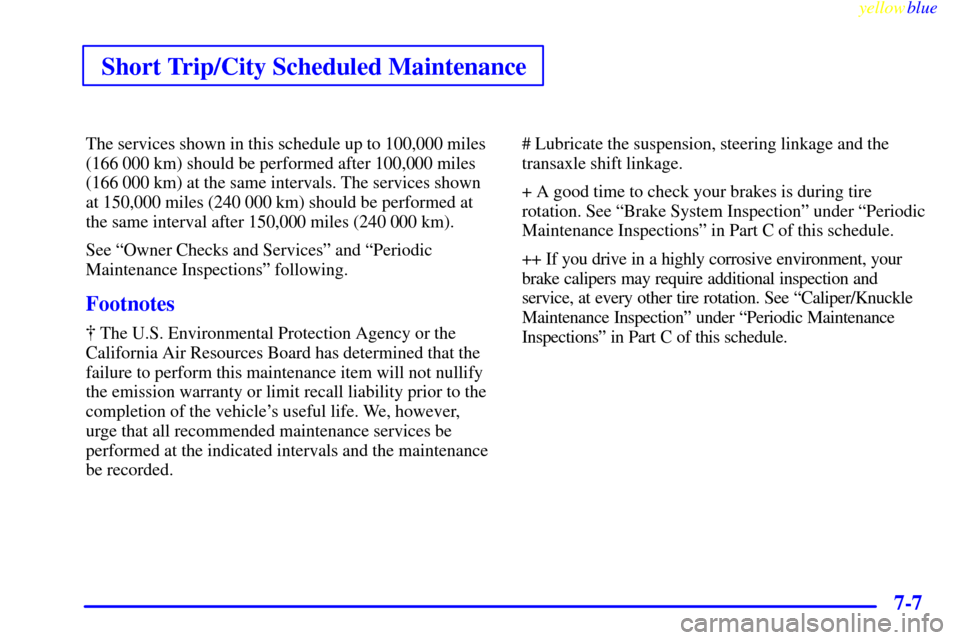
Short Trip/City Scheduled Maintenance
yellowblue
7-7
The services shown in this schedule up to 100,000 miles
(166 000 km) should be performed after 100,000 miles
(166 000 km) at the same intervals. The services shown
at 150,000 miles (240 000 km) should be performed at
the same interval after 150,000 miles (240 000 km).
See ªOwner Checks and Servicesº and ªPeriodic
Maintenance Inspectionsº following.
Footnotes
� The U.S. Environmental Protection Agency or the
California Air Resources Board has determined that the
failure to perform this maintenance item will not nullify
the emission warranty or limit recall liability prior to the
completion of the vehicle's useful life. We, however,
urge that all recommended maintenance services be
performed at the indicated intervals and the maintenance
be recorded.# Lubricate the suspension, steering linkage and the
transaxle shift linkage.
+ A good time to check your brakes is during tire
rotation. See ªBrake System Inspectionº under ªPeriodic
Maintenance Inspectionsº in Part C of this schedule.
++ If you drive in a highly corrosive environment, your
brake calipers may require additional inspection and
service, at every other tire rotation. See ªCaliper/Knuckle
Maintenance Inspectionº under ªPeriodic Maintenance
Inspectionsº in Part C of this schedule.
Page 323 of 368
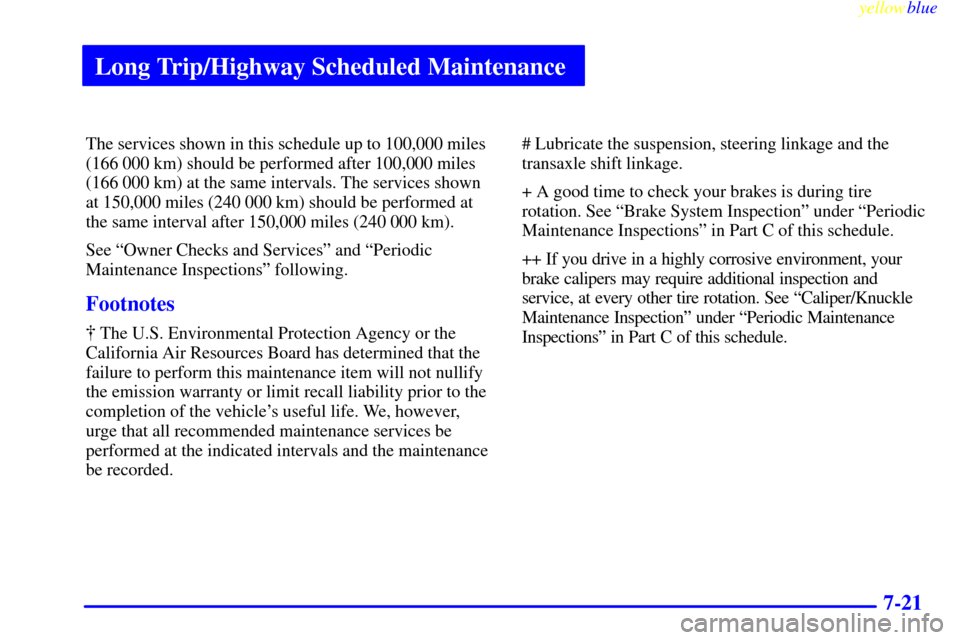
Long Trip/Highway Scheduled Maintenance
yellowblue
7-21
The services shown in this schedule up to 100,000 miles
(166 000 km) should be performed after 100,000 miles
(166 000 km) at the same intervals. The services shown
at 150,000 miles (240 000 km) should be performed at
the same interval after 150,000 miles (240 000 km).
See ªOwner Checks and Servicesº and ªPeriodic
Maintenance Inspectionsº following.
Footnotes
� The U.S. Environmental Protection Agency or the
California Air Resources Board has determined that the
failure to perform this maintenance item will not nullify
the emission warranty or limit recall liability prior to the
completion of the vehicle's useful life. We, however,
urge that all recommended maintenance services be
performed at the indicated intervals and the maintenance
be recorded.# Lubricate the suspension, steering linkage and the
transaxle shift linkage.
+ A good time to check your brakes is during tire
rotation. See ªBrake System Inspectionº under ªPeriodic
Maintenance Inspectionsº in Part C of this schedule.
++ If you drive in a highly corrosive environment, your
brake calipers may require additional inspection and
service, at every other tire rotation. See ªCaliper/Knuckle
Maintenance Inspectionº under ªPeriodic Maintenance
Inspectionsº in Part C of this schedule.
Page 334 of 368
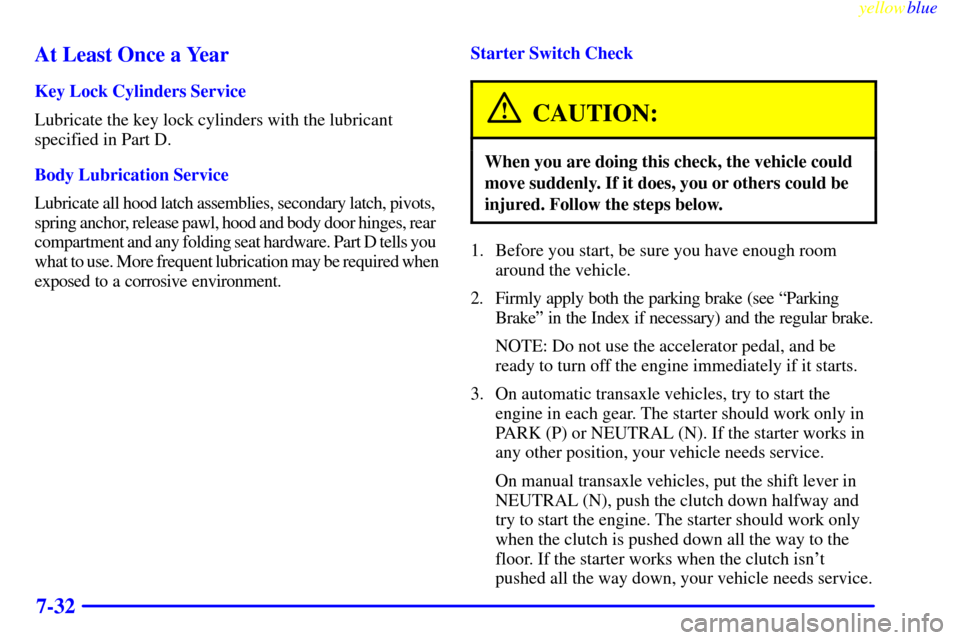
yellowblue
7-32 At Least Once a Year
Key Lock Cylinders Service
Lubricate the key lock cylinders with the lubricant
specified in Part D.
Body Lubrication Service
Lubricate all hood latch assemblies, secondary latch, pivots,
spring anchor, release pawl, hood and body door hinges, rear
compartment and any folding seat hardware. Part D tells you
what to use. More frequent lubrication may be required when
exposed to a corrosive environment.Starter Switch Check
CAUTION:
When you are doing this check, the vehicle could
move suddenly. If it does, you or others could be
injured. Follow the steps below.
1. Before you start, be sure you have enough room
around the vehicle.
2. Firmly apply both the parking brake (see ªParking
Brakeº in the Index if necessary) and the regular brake.
NOTE: Do not use the accelerator pedal, and be
ready to turn off the engine immediately if it starts.
3. On automatic transaxle vehicles, try to start the
engine in each gear. The starter should work only in
PARK (P) or NEUTRAL (N). If the starter works in
any other position, your vehicle needs service.
On manual transaxle vehicles, put the shift lever in
NEUTRAL (N), push the clutch down halfway and
try to start the engine. The starter should work only
when the clutch is pushed down all the way to the
floor. If the starter works when the clutch isn't
pushed all the way down, your vehicle needs service.
Page 335 of 368
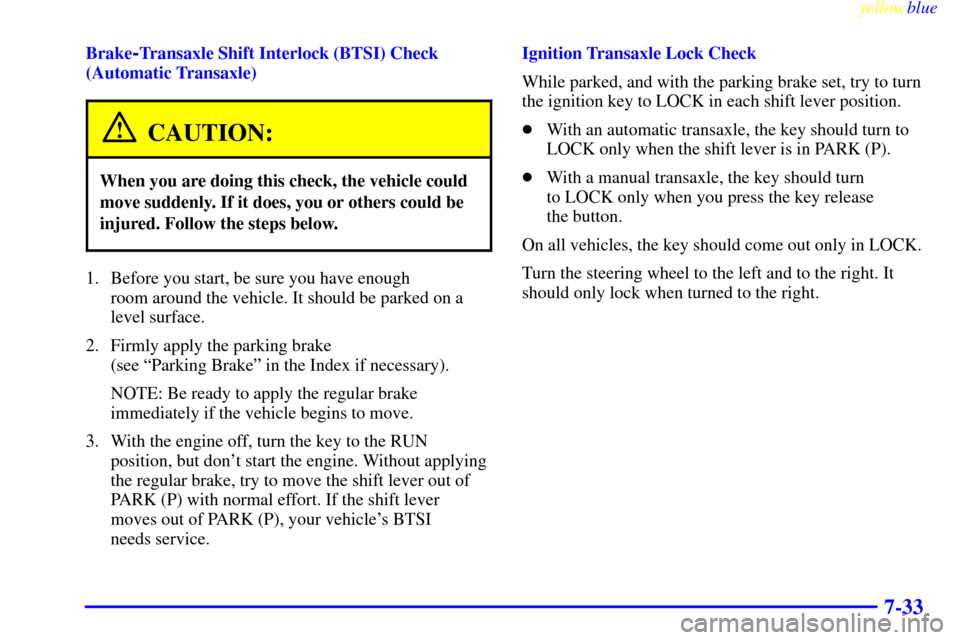
yellowblue
7-33
Brake-Transaxle Shift Interlock (BTSI) Check
(Automatic Transaxle)
CAUTION:
When you are doing this check, the vehicle could
move suddenly. If it does, you or others could be
injured. Follow the steps below.
1. Before you start, be sure you have enough
room around the vehicle. It should be parked on a
level surface.
2. Firmly apply the parking brake
(see ªParking Brakeº in the Index if necessary).
NOTE: Be ready to apply the regular brake
immediately if the vehicle begins to move.
3. With the engine off, turn the key to the RUN
position, but don't start the engine. Without applying
the regular brake, try to move the shift lever out of
PARK (P) with normal effort. If the shift lever
moves out of PARK (P), your vehicle's BTSI
needs service.Ignition Transaxle Lock Check
While parked, and with the parking brake set, try to turn
the ignition key to LOCK in each shift lever position.
�With an automatic transaxle, the key should turn to
LOCK only when the shift lever is in PARK (P).
�With a manual transaxle, the key should turn
to LOCK only when you press the key release
the button.
On all vehicles, the key should come out only in LOCK.
Turn the steering wheel to the left and to the right. It
should only lock when turned to the right.
Page 336 of 368
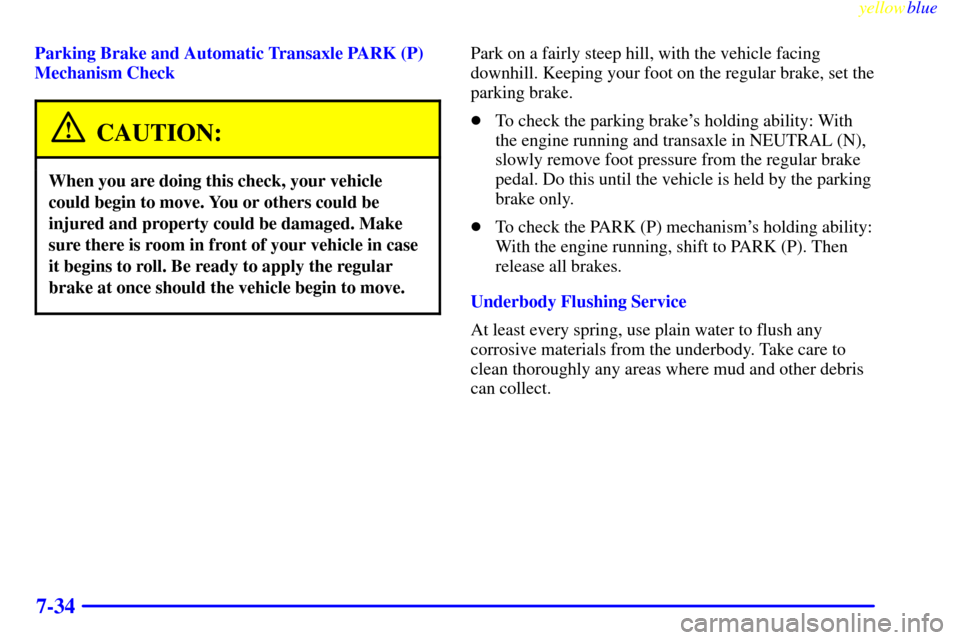
yellowblue
7-34
Parking Brake and Automatic Transaxle PARK (P)
Mechanism Check
CAUTION:
When you are doing this check, your vehicle
could begin to move. You or others could be
injured and property could be damaged. Make
sure there is room in front of your vehicle in case
it begins to roll. Be ready to apply the regular
brake at once should the vehicle begin to move.
Park on a fairly steep hill, with the vehicle facing
downhill. Keeping your foot on the regular brake, set the
parking brake.
�To check the parking brake's holding ability: With
the engine running and transaxle in NEUTRAL (N),
slowly remove foot pressure from the regular brake
pedal. Do this until the vehicle is held by the parking
brake only.
�To check the PARK (P) mechanism's holding ability:
With the engine running, shift to PARK (P). Then
release all brakes.
Underbody Flushing Service
At least every spring, use plain water to flush any
corrosive materials from the underbody. Take care to
clean thoroughly any areas where mud and other debris
can collect.
Page 338 of 368

yellowblue
7-36 Throttle System Inspection
Inspect the throttle system for interference or binding,
and for damaged or missing parts. Replace parts as
needed. Replace any components that have high effort
or excessive wear. Do not lubricate accelerator and
cruise control cables.
Brake System Inspection
Inspect the complete system. Inspect brake lines and
hoses for proper hook
-up, binding, leaks, cracks,
chafing, etc. Inspect disc brake pads for wear and rotors
for surface condition. Also inspect drum brake linings
for wear and cracks. Inspect other brake parts, including
drums, wheel cylinders, calipers, parking brake, etc.
Check parking brake adjustment. You may need to have
your brakes inspected more often if your driving habits
or conditions result in frequent braking.
Caliper/Knuckle Maintenance Inspection
If you operate your vehicle in a highly corrosive
environment, as indicated by the shaded areas on the
map following this text, your vehicle may require
additional brake service. Refer to the appropriate GM
Service Bulletin for the proper caliper inspection
procedure. As necessary, caliper pins and knuckle brake pad abutments should be lubricated at every other tire
rotation. Also, see your GM dealer's service department
or qualified service center for additional information.
X±02±0078±V